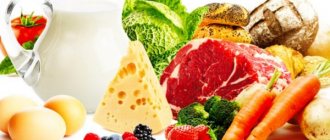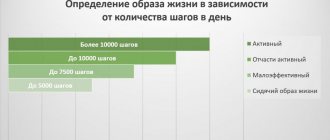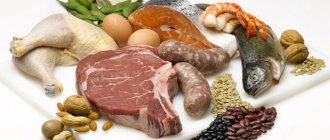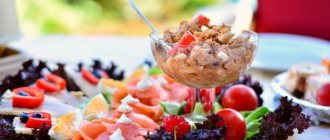Recently, a certain Ivan sent a Review 2021 (German Sugar Association, Berlin, Germany) asking for comment. The main conclusion from this review was this. “Taken together, current scientific evidence does not support the conclusion that dietary sugars themselves are harmful to human health.” I immediately agreed with this to myself, since it is not sugar itself that is harmful, but the glycemic load that makes up our diet. And this can only be determined using a glucometer individually and nothing else. Here is the link to the review www.ncbi.nlm.nih.gov/pubmed/30787473
In order to answer Ivan and at the same time inform others, let me comment on this review for all readers.
- This is a review of observational studies that cannot be used as evidence. Thus, the conclusions from them can be accepted with some degree of conditionality, even against the backdrop of the fact that a large body of such data is combined into meta-analyses in this 2019 review from German colleagues. Some might argue that observational studies can be evaluated statistically. And good statistical indicators can perhaps indirectly indicate the cause, and not just the effect. Thus, the British professor Udney Yule mentioned that in those years when many apples were imported to the UK, many divorces were registered. The correlation was large, statistically significant, even very significant, and there could be no mistake. But, fortunately, no one came to the conclusion that apples cause divorces or that divorces stimulate the import of apples (quote taken from the book “Evidence-Based Medicine 0.05” by Peter Talantov).
- This review shows that whether a person gains fat mass or not depends on calorie content, and not on the very fact of the presence of carbohydrates. It would be strange to think that you eat one piece of bread and suddenly get fat. There is nothing surprising about this. Since it is not the sugar itself that is important, but the glycemic load. What this review actually says is “Therefore, through the highest scientific evidence of human studies, it can be concluded that the consumption of free sugars will only result in overweight and obesity if more calories in the form of free sugars are consumed than expended. Free sugars per se do not favor body weight gain as shown by isocaloric exchange with other carbohydrates.”
- The diabetes section concludes that sugars increase the risk of type 2 diabetes provided they add calories to the diet. “All in all, the results from prospective cohort studies and controlled intervention trials indicate that SSBs contribute to the development of T2D by adding excessive calories to the diet resulting in a positive energy balance, but no effects on parameters of glycemic control were seen under isocaloric conditions [30]. All energy-containing beverages, including SSBs as well as fruit juices, should be seen in the same way in their effects on health due to their similar amount of calories and sugar content.” This once again speaks in favor of a low glycemic load diet. Or with an optimal glycemic load - as you wish. I won’t quote it again and will tell you straight away from the content. The review concludes that the Glycemic Index of a product is not important. Yes. Not important. Because the glycemic load is important. You can eat a lot of food with a low glycemic index and your blood sugar will rise, or you can eat only a very small amount of food with a high glycemic index, and your blood glucose will rise slightly. It is also important to note that with a calorie deficit, insulin sensitivity is better and there is no strong spike in sugar, which explains why the risk of diabetes does not increase with a low calorie diet.
- SEPARATELY, IT IS IMMEDIATELY WORTH EXPLAINING THAT IT IS NOT SUGAR IN HEALTHY PEOPLE THAT DAMAGES THE VESSELS, AS SOME THINK, AND THE “SWING” CAUSES A DECREASED SENSITIVITY TO INSULIN AND IN THE FAR FUTURE DIABETES WHEN GLUCOSE IS HIGHLY INCREASED, AND THEN DROP STRONGLY IN RESPONSE TO A HIGH GLYCEMIC LOAD DIET .
- As an example, I’ll tell you my experience. I did an experiment when I decided to eat a lot of food at a buffet in one of the hotels. Eat so much that you can’t fit any more, but so that my sugar doesn’t rise. And I simply chose from food that in total did not have a high glycemic load. So my blood glucose did not rise above 5.6 after 30 minutes, nor after 60, nor after 90 minutes - this is the level of an almost hungry person. I mainly chose boiled beans, vegetable salads, legumes, cheeses, eggs, meats, coffee and the like. The carbohydrates themselves were sufficient. But the glycemic load is “no”. As a result, this approach does not cause a decrease in insulin sensitivity, since it does not cause “blood glucose swings.” And many who took blood tests for the HOMA-IR insulin resistance index saw how much it either fell or increased depending on the glycemic load of the diet a month before the blood test.
- The section on the effect of sugars on cardiovascular disease (CVD) risk states that obesity is a major risk factor for CVD, and therefore dietary recommendations for CVD prevention should focus on controlling obesity and reducing caloric intake rather than reducing intake of one “It is well known that obesity is a major risk factor for CVDs [35] and therefore, nutritional recommendations to prevent CVDs should focus on tackling obesity and reducing calorie intake rather than focusing on the reduced intake of a single nutrient.” And it is right. That is why it is important not what foods the diet contains, but what nutritional principles it follows. That is, if a diet does not increase insulin resistance (not a high glycemic load), then it does not matter what is in it. I’ll say right away that it is impossible to calculate the glycemic load using any formulas. It depends on the individual characteristics of the person, on the time of day, on the time of meal (whether the meal was preceded by sports training) and so on. This is why there are often mixed results in studies on sugars, which sometimes emphasize that the risks of insulin resistance do not depend on sugar, but on lifestyle, etc. Therefore, it is not sugar that is important, but the glycemic load. It’s not the products you need to select, but a glucometer in your hands and measuring your blood sugar after eating and learning to understand your body, how and what it reacts to.
- Not surprisingly, there is a similar logic in the section on sugar and cancer.
Therefore, when someone brings you a diet designed for healthy eating, do not believe in any miracle nutrition. It doesn’t matter what your diet consists of (unless, of course, you already have diabetes, in which everything changes). Pick up a glucometer and check.
How to check?
What should the maximum blood glucose level be 60 minutes after a meal for the meal to be considered healthy and prevent cardiometabolic consequences, as well as cancer in the future? Here's how to determine it.
Step 1. Buy a Glucometer.
Step 2. Measure glucose before meals at rest.
Step 3. Eat
Step 4. Measure glucose after eating - after 60 minutes. We try to keep the glucose level after meals no higher than 6.
Step 5. After a month, we take a blood test to determine HOMA-IR. Fasting insulin
Fasting glucose. We calculate HOMA-IR = Glucose mmol/l * Insulin (µIU/ml) / 22.5.
Step 6. If HOMA-IR is not higher than 1.4, calibrate the target postprandial glucose value
Step 7. We look for our own recipes and our own amounts of food to do without a glucometer.
Step 8. We periodically take a blood test to calculate HOMA-IR for control.
That is, for some it could be 5.6 mmol/l, and for others 7 mmol/l - it all depends on the HOMA-IR result at the end of the month.
Decreased insulin sensitivity, even without a diagnosis of type 2 diabetes, increases mortality. Such conclusions were made by scientists in the USA from the University of Washington (Seattle, Washington) based on the results of 12 years of observation in 2010. The risk of mortality was significant even after adjustment for potential confounders (age, sex, body mass index, waist and hip circumference, alcohol consumption, race/ethnicity, education level, smoking status, physical activity, c-reactive protein, systolic and diastolic blood pressure, plasma total and HDL cholesterol and triglycerides). The HOMA-IR insulin resistance index was significantly associated with all-cause mortality only in patients with a Body Mass Index of no more than 25.2 kg/m(2). But in patients with a Body Mass Index above 25.2 kg/m(2), no such association was observed. An increased body mass index itself is a risk in itself.
- Reference values for the HOMA-IR insulin resistance index: <1.5.
- HOMA-IR >1.4 - higher mortality from all causes, provided that the Body Mass Index is not higher than 25.2 kg/m2
- If the body mass index is above 25, but HOMA-IR can no longer be interpreted. Link to the study:
- www.ncbi.nlm.nih.gov/pubmed/20200308
The review that Ivan sent further confirms the role of nutrition, which is based primarily not on products, but on principles. And the central one is low glycemic load (not to be confused with the glycemic index).
This is food
https://nestarenie.ru/video-dieta.html
Why the glycemic index of foods is important for weight loss
In response to the intake of different complex carbohydrates, blood sugar levels rise in different ways.
The glycemic index reflects how much certain foods increase blood glucose levels and how long the increase lasts.
Currently, GI has been calculated for a huge number of products. And depending on the value of this parameter, they are all divided into three categories:
- products with high GI – from 70-100;
- with average – 50-70;
- with low – below 50.
When we eat foods with a high GI, blood sugar rises quickly and significantly. After a meal with foods with low GI, the level of glucose in the blood also increases, but not quickly and not much.
That is, the glycemic index reflects how quickly food in the body turns into sugar.
In response to increased blood glucose levels, the pancreas synthesizes insulin. And the more sugar in the bloodstream, the faster and in greater volume insulin is released.
Moreover, it is high levels of insulin that underlie many serious human diseases, including excess weight gain and obesity.
You can learn how insulin contributes to the formation of excess fat deposits in this article from the section “High Insulin Levels Lead to Obesity.”
When there is a lot of insulin, blood sugar levels drop very quickly. Hypoglycemia begins. As a result, the person again attacks food. And this behavior leads to further weight gain and poor health.
Low GI foods do not lead to a significant release of insulin and, therefore, are not a cause of obesity. The body after them is in a healthier and more stable state.
Recommendations for creating a menu
The basis of a low-carbohydrate diet is animal and plant proteins
When using information from the tables to create a healthy menu, you need to focus on the following factors:
- avoid foods with high calorie content despite low GI,
- give preference to fish, seafood and food supplements containing Omega-3 unsaturated fatty acids,
- calculate the amount of proteins according to the following scheme: 2 g per kilogram of body weight, while 60% of the resulting figure should be represented by plant proteins, and 40% by animal proteins,
- choose protein components with low calorie content,
- expose products to frying or frying processes as little as possible, and use a minimum amount of refined vegetable oils, giving preference to olive,
- avoid frequent consumption of foods with simple carbohydrates, give preference to complex polysaccharides - legumes, vegetables, fruits and berries,
- High GI foods should be accompanied by salads, herbs and fresh vegetables with low GI.
What is glycemic load?
Glycemic load (GL) is a comparison of the quality of carbohydrates (that is, their glycemic index) and their quantity in different foods.
GN does not measure how quickly food turns into sugar. It reflects how much a particular food product contains of substances that can turn into sugar in principle.
Just like GI, glycemic load shows how much a particular food increases blood sugar levels and triggers the release of insulin.
The lower the GN of a product, the slower the amount of glucose increases after its consumption, and the less insulin is synthesized. As a result, blood sugar levels are more stable and hypoglycemia does not develop.
Based on the glycemic load, all food products are divided into three categories:
- with high GN – 20 and above;
- with average – 11-19;
- from low – up to 10 inclusive.
Precautions when using a low glycemic index diet
Keep in mind that we need carbohydrates, especially unprocessed ones, to maintain energy and strength in the body. We all know the infamous saying: “An apple a day keeps the doctor away.” Despite the glycemic index of fruits such as apples, peaches, strawberries, which contain sugar or carbohydrates, they are healthy foods. They enrich the body with essential nutrients. Thus, eliminating all simple carbohydrates as a strict rule would mean eliminating these and other healthy simple carbohydrates from the diet.
This is when the glycemic index and glycemic load can get complicated, but it shouldn't. Nutritionists, doctors, scientists and researchers have realized that there are simple carbohydrates that are good for the body. There are also complex carbohydrates that can cause unhealthy reactions in the body.
When it comes to choosing the best foods, choose those that are least processed. Fruits, whole grains, sweet potatoes and others listed on the glycemic index do not need to be excluded from your diet. It's about balance and eating real foods as part of a well-balanced, low glycemic index diet.
There are many charts, graphs, measurements and glycemic index calculation tools available. When it comes to foods that we should or should not include in our diet, we should rely on them. We advise you to adhere to these recommendations. Eat a variety of natural foods and avoid processed foods.
Final thoughts
- What does a high glycemic index mean? The glycemic index of a food tells how quickly the food turns into sugar after it is consumed. Many fruits and vegetables that rank high on the glycemic index scale have a low glycemic load. Glycemic load is the effect of one serving of carbohydrate-containing foods on blood sugar levels. Therefore, the glycemic load is in most cases a more accurate indicator compared to the glycemic index. This is very important when it comes to which carbohydrates are healthy.
- A low glycemic index diet can help normalize blood sugar levels and prevent insulin resistance.
- What foods have a high glycemic index? Refined grains, sugary drinks, dried fruits and processed foods generally have a higher glycemic index. And foods such as whole grains, vegetables, nuts, seeds and legumes have a low glycemic index.
- To reduce the glycemic load of your diet, experts recommend making some of the following changes:
- 1. Consume unprocessed grains, but reduce consumption of flour and white refined grains;
- Eat more legumes, nuts and seeds;
- Eat less starchy foods such as potatoes, rice and bread;
- Reduce or avoid sugary foods such as cookies, cakes, candy, and soft drinks;
- Pair high-glycemic index foods with proteins and healthy fats to make meals more filling.
What is more important: GI or GL?
Both are important.

The glycemic index reflects the quality of carbohydrates. But it does not show their number. Glycemic load speaks volumes. Therefore, in order to maintain sugar levels at a relatively constant level, both GI and GL must be taken into account.
So to achieve the same blood sugar level, you can eat twice the amount of a food with a GI of 50 as a food with a GI of 100.
In addition, it is necessary to understand that a product with a high glycemic index does not always have a high GL.
A typical example of such a product is watermelon. It has a high GI, but the load is low.
In addition to watermelon, many other fruits and vegetables correspond to this ratio (high GI - low GL).
However, the low GL in many of them does not mean that they are absolutely useful. Since in addition to carbohydrates, which are converted directly into glucose in the body and that is why they can have a negative effect on health, there are also carbohydrates in the world that do not convert into glucose, but have a strong negative effect on the body.
An example of such carbohydrates is fructose, which is found in many foods.
In this infographic, you can see how fructose affects the body differently from regular sugar, and why fructose may be even more dangerous in many ways.
Pivot tables for products, dishes and drinks
The following tables of products with GI and GL indicators are not exhaustive or final.
Each product is rated on a scale of 100, where:
- a glycemic “glucose” index below 40 is characterized by absence, from 40 to 70 - moderate, and above 70 - rapid insulin response,
- the glycemic load is considered low with values from 0 to 10, medium - from 11 to 19, high - more than 20, and the total daily value should range from 60 to 150 units.
The “General Rating” from 0 to 10 characterizes the product solely from the point of view of weight loss, where 0 means the product is not recommended for use. When deriving this assessment, the totality of all components was taken into account - GI, GL, calorie content and the quantitative ratio of proteins, fats and carbohydrates.
Vegetables

Before adding mushrooms to your diet menu, consult your doctor.
Berries and fruits

Nutritionists from the USA have proven that grapefruit contains substances that lower blood sugar
Products made from flour and cereals
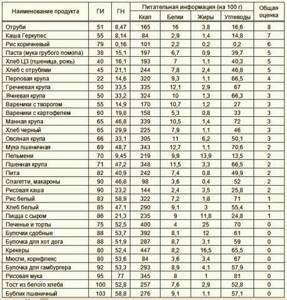
It is still better for diabetics to use vegetables as a side dish.
Beverages
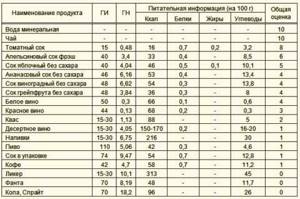
The daily requirement of clean water is calculated individually
Dairy
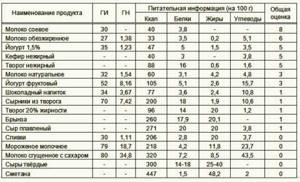
The most dangerous food combination is fruit yogurt + oatmeal
Cooking fats and sauces

Salo, in small quantities, stimulates the liver
Meat, eggs
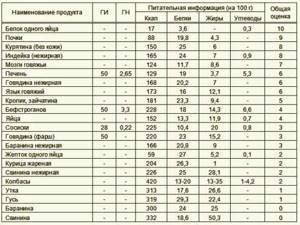
It is better to eat natural meat, and cooked in one piece, rather than minced meat.
Miscellaneous
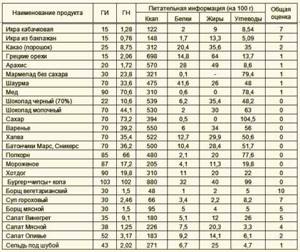
Another favorite, but very dangerous fast food combination is a burger, chips and Coca-Cola.
The video in this article will help you learn to confidently use glycemic index tables.
Table of glycemic load and food index
The complete table of parameters for the most common foods containing carbohydrates is as follows.
| Products | GI | A portion | GN |
| Sweets | |||
| Honey | 87 | 1 tsp | 3 |
| Lollipops | 78 | 28 g | 22 |
| Snickers | 68 | 60 g (half) | 23 |
| Table sugar | 68 | 2 tsp | 7 |
| Strawberry jam | 51 | 2 tsp | 10.1 |
| Dark chocolate | 23 | 35 g | 4.4 |
| Baking and cereals | |||
| French baguette | 95 | 1 piece | 29.5 |
| Donut | 76 | 1 (about 75 g) | 24.3 |
| Waffle (homemade) | 76 | ! (about 75g) | 18.7 |
| Millet | 71 | 150 g | 26 |
| Regular loaf | 70 | 1 piece | 7.7 |
| Corasan | 67 | 1 medium | 17.5 |
| Muesli | 66 | 2/3 cup | 23.8 |
| Oatmeal (quick) | 65 | 1 glass | 13.7 |
| 100% rye bread | 65 | 1 piece | 8.5 |
| Rye bread | 65 | 1 (about 25g) | 11.1 |
| Blueberry muffin | 59 | 1 medium | 30 |
| Regular oatmeal | 58 | 1/2 cup | 6.4 |
| Wheat pita | 57 | one | 17 |
| Oat cookies | 55 | 1 large | 6 |
| Popcorn | 55 | 1 glass | 2.8 |
| Buckwheat | 55 | 150 g | 16 |
| Spaghetti | 53 | 180 g | 23 |
| Potato dumplings | 52 | 150 g | 23 |
| Bulgur | 46 | 150 g | 12 |
| Vanilla sponge cake with vanilla glaze | 42 | 1 piece | 16 |
| Chocolate sponge cake with chocolate icing | 38 | 1 piece | 12.5 |
| Dumplings | 28 | 100 g | 6 |
| Beverages | |||
| Cola | 63 | 330 ml | 25.2 |
| Orange juice | 57 | 1 machine | 14.25 |
| carrot juice | 43 | 1 glass | 10 |
| Cocoa with milk | 51 | 1 glass | 11.7 |
| Grapefruit juice | 48 | 1 glass | 13.4 |
| Pineapple juice | 46 | 1 glass | 14.7 |
| Soy milk | 44 | 1 glass | 4 |
| Apple juice | 41 | 1 glass | 11.9 |
| Tomato juice | 38 | 1 glass | 3.4 |
| Legumes | |||
| Lima beans | 31 | 1 glass | 7.4 |
| Chickpeas | 31 | 1 glass | 13.3 |
| Lentils | 29 | 1 glass | 7 |
| Regular beans | 27 | 1 glass | 7 |
| Soya beans | 20 | 1 glass | 1.4 |
| Peanut | 13 | 1 glass | 1.6 |
| Vegetables | |||
| Carrot | 92 | 1 medium | 1 |
| Beet | 64 | 1 medium | 9.6 |
| Corn | 55 | 1 glass | 61.5 |
| Green pea | 48 | 1/2 cup | 3.4 |
| Tomato | 38 | 1 medium | 1.5 |
| Broccoli | 0 | 1/2 cup (boiled) | 0 |
| Cabbage | 0 | 1/2 cup (boiled) | 0 |
| Celery | 0 | 60 g | 0 |
| Cauliflower | 0 | 100g (1 cup) | 0 |
| Green bean | 0 | 1 glass | 0 |
| Mushrooms | 0 | 70 g | 0 |
| Spinach | 0 | 1 glass | 0 |
| Fruits | |||
| Watermelon | 72 | 1 cup pulp | 7.2 |
| A pineapple | 66 | 1 glass | 11.9 |
| Cantaloupe | 65 | 170 g | 7.8 |
| Canned apricots | 64 | 1 glass | 24.3 |
| Raisin | 64 | 43g | 20.5 |
| Canned peach | 58 | 262g (1 cup) | 28.4 |
| Kiwi | 58 | one | 5.2 |
| Bananas | 51 | 1 medium | 12.2 |
| Mango | 51 | 160 g | 12.8 |
| Orange | 48 | one | 7.2 |
| Canned pears | 44 | 250 g | 12.3 |
| Grape | 43 | 1 glass | 6.5 |
| Strawberry | 40 | 1 glass | 3.6 |
| Apples | 39 | 1 medium without skin | 6.2 |
| Pears | 33 | 1 medium | 6.9 |
| Dried apricots | 32 | 1 glass | 23 |
| Prunes | 29 | 1 glass | 34.2 |
| Peaches | 28 | 1 medium | 2.2 |
| Grapefruit | 25 | 1/2 medium | 2.8 |
| Plums | 24 | one large | 1.7 |
| Cherries | 22 | 1 glass | 3.7 |
| Nuts | |||
| Cashew | 22 | ||
| Almond | 0 | ||
| Hazelnut | 0 | ||
| Macadamia | 0 | ||
| Pecan | 0 | ||
| Walnut | 0 | ||
| Dairy | |||
| Low fat ice cream | 47 | 1/2 cup | 9.4 |
| Milk pudding | 44 | 1/2 cup | 8.4 |
| Milk | 40 | 1 glass | 4.4 |
| Regular ice cream | 38 | 1/2 cup | 6 |
| Yogurt (without additives) | 36 | 1 glass | 6.1 |
* GI and GL data for common foods such as rice and potatoes, as well as all protein and fatty foods, are discussed separately below.
** The table shows average values, especially when it comes to complex dishes, such as baked goods.
Nutrition Data Glycemic Load Estimate
Estimated glycemic loads appear on Nutrition Data (ND) pages and have a format similar to the example on the right (if you don't understand how to use the ND search, see the example here):
Estimated Glycemic Load change if you change the serving size at the top of the page.
Note : For more information on glycemic index values obtained from the University of Sydney, Australia, see GlycemicIndex.com.
- Related Posts
- Potato starch: benefits and harm to the body
- What foods are high in sulfur and how does it affect the human body?
- Shelf life of rice (packaged, boiled) and whether it can go bad
« Previous entry
Dependence of the glycemic index of a product on the method of its preparation
- A large amount of fat in a dish can slightly reduce the GI. So if a product with a high GI was fried in oil, its glycemic index decreased.
- Baking and grilling increase the GI of foods rich in resistant starch by breaking it down. Therefore, for products with resistant starch, cooking in water is most suitable, as it does not lead to the breakdown of complex carbohydrates.
- The longer foods such as pasta or rice are cooked, the higher their GI becomes.
- When assessing the GI value of fruits, it is important to take into account their ripeness. The more ripe the fruit, the higher its GI. This is especially clearly noticeable on bananas, the index of which can range from 30 to 51 depending on ripeness.
What does the glycemic index depend on?
Nutritional factors affecting the glycemic index:
| What type of monosaccharides are in food | What type of starches are found in food? | How the food was prepared | Presence of other food components |
| Glucose | Amylose (helical form of starch molecule) | Degree of starch breakdown during cooking | Fats and protein foods |
| Fructose | Amylopectin (branched form of starch molecule) | Degree of food grinding | Dietary fiber and indigestible fiber |
| Galactose | Ratio of nutrient component to indigestible fiber | Form of dish (liquid or solid) | Presence of non-nutrients |
| Resistant starch (4 classes of starch, slow digestion) | Preservation of the cellular structure of the product | Organic acids |
It should also be noted that the glycemic index of natural products depends on their degree of maturity, their sugar content and the area where they grew. Therefore, such tables can only give an indicative indicator, which is more correctly used to compare products with each other.
The rate of glucose absorption was taken as the basis for calculating the glycemic index. After receiving the glucose load, the area under the curve of the amount of sugar in the blood is measured, which is taken at intervals of 20-30 minutes. The curve area for glucose application was assigned 100 units. Other products with an equivalent amount of carbohydrates in their composition are calculated in relation to it.
Source fat-down.ru
Wide variability in the glycemic index of rice and potatoes
What is the GI of rice and potatoes? This question is often asked by both scientists and people far from science. It's not easy to answer.
The fact is that the data on these two simple food products varies so much that it is almost impossible to give an average value.
Thus, the glycemic index of rice can range from 54 to 132, and of potatoes - from 67 to 158.
Why are the GI data for rice and potatoes so different?
Because the content of amylose and amylopectin varies in different varieties. The more amylose, the lower the glycemic index.
There are 4 main varieties of rice:
- long grain;
- medium grain;
- short grain;
- sweet or sticky (commonly used to make sauces in Asian restaurants).
Sweet rice contains no amylose at all. And its GI is maximum. Long-grain varieties, for example, Basmani, have the most amylose, and therefore their GI is minimal.
Additionally, each of these rice varieties can be white or brown. Brown always has a lower GI than white.
So, if we are talking about the popular Basmani rice, then its white form has a glycemic index of 83. The exact GI of brown Basmani has not yet been established, but scientists suggest that it is minimal, that is, about 54.
You can read more about how a grain of rice works and how its consumption affects weight loss in this article.
The situation is similar with potatoes. Different varieties have different amylose to amylopectin ratios, and therefore different GI values.
Moreover, young potatoes always have a lower glycemic index than more mature potatoes of the same variety. This is due to the fact that as the tubers mature, they contain less and less amylose and more and more amylopectin.
Is it possible to “outsmart” GI and GN?
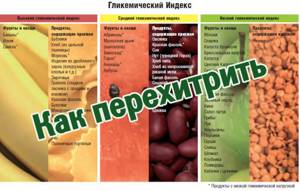
It turns out, quite! Indeed, depending on the form in which we consume this or that product, the glycemic index, and therefore the glycemic load, may change.
Industrial processing of a product can lead to an increase in GI (for example, corn flakes have a GI of 85 and corn has a GI of 70; instant mashed potatoes have a GI of 83 and boiled potatoes have a GI of 70). This means that it is preferable to consume products in their natural form.
Cooking can also lead to an increase in GI. Raw vegetables and fruits have a lower glycemic index than cooked ones. So, boiled carrots have an index of 85, and raw carrots - 35. If vegetables still need heat treatment, it is not recommended to boil them, because. At the same time, fiber is not destroyed, which is very important. The more fiber in a food, the lower the total glycemic index. In addition, vegetables and fruits are best consumed with their peels. And not only because the lion's share of vitamins is located directly on the skin, but also because it is the skin that consists of valuable fiber.
The more a product is crushed, the higher its glycemic index. This mainly applies to grains. For example: GI of soft buns - 95, white loaves - 70, wholemeal bread - 50, whole flour bread - 35, refined rice - 70, and unrefined rice - 50. So if you eat porridge, then only from whole grains , and bread is made from whole flour with bran, and not refined products.
Acid slows down the process of food absorption. This is why the GI of unripe fruits is lower than their ripe counterparts. The GI of some dishes can be reduced by adding, for example, vinegar (to salad dressing or marinade).
When composing your diet, in no case should you focus only on the glycemic index and glycemic load of foods. It is always necessary to take into account the energy value of food, its content of salt, fat, essential vitamins, minerals and amino acids.
Source zdorovieinfo.ru




